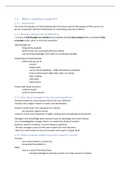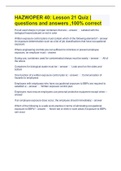Module 1: Organizing and Society
What is a Crisis?
- Banking crisis
- Eu Crisis (Greece)
- Climate crisis
etc etc
“We do not know what the next crisis will look like, when it wil strike and how we can recognize it
before it occurs…”
Such crisis are systemic and epidemic
1. Crisis reflect system breakdowns (its not an incident)
2. Are these crisis primarily economic or political?
3. Or could these crises also be … organiational?
4. Which role do organization processes play?
5. This is the question we will address today
6. This question will remain with us during the course
7. Crisis are very instructive, because they tend to reveal the often taken-for-granted and hidden basic
features of organizational systems
Continuity and change or continuous change?
1. Do organizations constitute relatively stable structures, which sometimes change?
2. Or, are 21st century organizations better conceived as continuously changing, in which cas stability
is the exception rather than the rule
3. Organizations change because of internal dynamics, interaction with each other and because of
interaction with society.
Leading questions of the course?
What do we mean with “organizing”?
How does “organizing” relate to “society”?
Non-formal, Non-organizational modes of ordering
1. Institutions
2. Networks
3. Markets
4. Associations
5. Clubs and Societies
6. (Virtual) technologies
7. Independent professional workers
8. (Sub)cultures
9. Kinship relations
10. Social movements
11. Entrepreneurship
, Orders
Emergent orders: Decided orders:
-Institutions <-> -Organizations
-Networks
Course objectives:
1. Understand organizations as decided orders along various dimensions
2. Learn to see societies as increasingly organized
3. Problematize technological, network and institutional tensions & pressures
4. Reflect on literature and relevant cases
5 Major themes
-Risk and Crisis Management (Kingma)
-CSR and Social Movements (Kingma/ Van den Broek)
-Technology and Virtualizing organizations (Kingma)
-Identity, Gender ( Vrabiescu)
-The future and resilience (Nonnekes/ Kingma)
Leading questions?
-What are we talking about when we speak of “Organizing and organization”?
-And how does “organization” relate to “institution” and “Network”?
Main elements of Organization
1. Membership
2. Hierarchy
3. Rules
4. Monitoring
5. Sanctions
“Complete Organizations” possess, and “Partial Organizations” do not possess all of these
attributes…
Institutions
1. Scott (2001): “Institutions are social structures that have attained a high degree of resilience. They
are composed of cultural-cognitive, normative, and regulative elements that, together with associated
activities and resources, provide stability and meaning to social life”
2. Czarniawska (2009) : “an observable pattern of collective action, justified by a corresponding
norm”
Networks
“A network consist of informal structures of relationships linking social actors, which may be
persons, teams or organizations”
Organization as a dominant process:
Meyer and bromley (2006): “a worldwide explosion of organizations and organizing”
-in numbers
- in domains
- in intensity
,Perrow (1991): the increasing dominance over social life of LARGE organizations. Banks are a clear
example
- formalization, professionalization, and standardization
Characteristics of contemporary formal Organization (Meyer and Bromley 2013)
1. Identity 2. Means-Ends purposiveness
a) Sovereignty a) Ends
b) Citizenship b) Means
c) Control and information c) Resources
The worldwide Expansion of “Organization” (Meyer and Bromley 2013)
-Significance of “actorhood” (decided orders)
-Increasing number of “Organizations”
-More fields are “organized”
-Organizations are “formalized”
-Organizational reach is “expanding”
-Are organizations becoming omnipotent and exploitative “Big Brothers”?
Explaining the expansion of organization (Meyer and Bromley 2013)
-Globalization (increasing competition and exchange)?
-Increasing efficiency and effectiveness?
-Capitalist interests?
-However: the rate of organization exceeds the rate of economic growth, by far…
-Thus: Expanded organizing as a cultural and political process!
-The organization as a dominant cultural formation!
-The key role of education
Features of modern organization (Meyer and Bromley 2013)
-Expansion of social horizons
-”World society is perceived as a central locus of our activity”
-Cultural Rationalization
-Environmental Rationalization
-Authority
-Networking; learning; flexibility; professionalism; social responsibility; distributed power;
reflexivity; teamwork; increasing uncertainties
Complete and Partial Organizing for Corporate Social Responsibility (Rascche et.al. 2013)
-From Corporate Centered to Corporate Oriented
-Focus on Various organizational elements (membership etc.)
-Weaknesses in monitoring and sanctioning
-The importance of “CSR Standards“ and “CSR Partnerships”
-CCO (Communication constitutes organization)
, Module 2: Risk, responsibility and crisis
management
Thema: Responsibility in casinos
What's the problem?
-Current debate: Can we liberalize (internet) gambling organizations?
-How can we prevent problem gambling?
-What is the responsibility of governments and gambling organizations?
-Does ‘responsible gambling’ go beyond “window dressing” ?
Link with overall themes..
-A new social field is being organized
-Risk and rationalization: risk produces “decided orders” (overall course theme!)
-The difference between risk and uncertainty
-Responsibilization and institutionalization
-Risk and stakeholders (networking: health care and science)
-How are risk and responsibility connected (Kingma 2019)?
Responsible gambling
-Claims Unibet: Informs gamblers about the “ risks involved”
Invested 200 million in creating a “ secure and safe gambling environment”
Zero tolerance “toward fraud and theft”
Offers practical tools to “ prevent gambling from getting out of hand”
“ Research” has indicated that online gambling has not led to an increase of gambling
addiction”
“ We do whatever we can to protect your safety”
What is “Responsible Gambling” ?
-It is a business trend
-” Voluntary” program to reduce negative externalities, such as “ problem” gambling
-Includes “ Self-exclusion” as the most rigorous tool
-Companies should not knowingly do anything that could harm stakeholders
-Companies should rectify harms when they are discovered and brought to their attention
-The actual meaning of RG will depend upon the situation, and is relative to societal expectations and
the managerial perception and understanding of these
Objectives responsible gambling
-Countering underage gambling and problem gambling
-Risk-management and self-regulation
-Information and awareness raising
-Self-exclusion programs for problem gamblers
-Advertising restrictions and gambling limits
-Partnering with treatment agencies and GA
What is a Crisis?
- Banking crisis
- Eu Crisis (Greece)
- Climate crisis
etc etc
“We do not know what the next crisis will look like, when it wil strike and how we can recognize it
before it occurs…”
Such crisis are systemic and epidemic
1. Crisis reflect system breakdowns (its not an incident)
2. Are these crisis primarily economic or political?
3. Or could these crises also be … organiational?
4. Which role do organization processes play?
5. This is the question we will address today
6. This question will remain with us during the course
7. Crisis are very instructive, because they tend to reveal the often taken-for-granted and hidden basic
features of organizational systems
Continuity and change or continuous change?
1. Do organizations constitute relatively stable structures, which sometimes change?
2. Or, are 21st century organizations better conceived as continuously changing, in which cas stability
is the exception rather than the rule
3. Organizations change because of internal dynamics, interaction with each other and because of
interaction with society.
Leading questions of the course?
What do we mean with “organizing”?
How does “organizing” relate to “society”?
Non-formal, Non-organizational modes of ordering
1. Institutions
2. Networks
3. Markets
4. Associations
5. Clubs and Societies
6. (Virtual) technologies
7. Independent professional workers
8. (Sub)cultures
9. Kinship relations
10. Social movements
11. Entrepreneurship
, Orders
Emergent orders: Decided orders:
-Institutions <-> -Organizations
-Networks
Course objectives:
1. Understand organizations as decided orders along various dimensions
2. Learn to see societies as increasingly organized
3. Problematize technological, network and institutional tensions & pressures
4. Reflect on literature and relevant cases
5 Major themes
-Risk and Crisis Management (Kingma)
-CSR and Social Movements (Kingma/ Van den Broek)
-Technology and Virtualizing organizations (Kingma)
-Identity, Gender ( Vrabiescu)
-The future and resilience (Nonnekes/ Kingma)
Leading questions?
-What are we talking about when we speak of “Organizing and organization”?
-And how does “organization” relate to “institution” and “Network”?
Main elements of Organization
1. Membership
2. Hierarchy
3. Rules
4. Monitoring
5. Sanctions
“Complete Organizations” possess, and “Partial Organizations” do not possess all of these
attributes…
Institutions
1. Scott (2001): “Institutions are social structures that have attained a high degree of resilience. They
are composed of cultural-cognitive, normative, and regulative elements that, together with associated
activities and resources, provide stability and meaning to social life”
2. Czarniawska (2009) : “an observable pattern of collective action, justified by a corresponding
norm”
Networks
“A network consist of informal structures of relationships linking social actors, which may be
persons, teams or organizations”
Organization as a dominant process:
Meyer and bromley (2006): “a worldwide explosion of organizations and organizing”
-in numbers
- in domains
- in intensity
,Perrow (1991): the increasing dominance over social life of LARGE organizations. Banks are a clear
example
- formalization, professionalization, and standardization
Characteristics of contemporary formal Organization (Meyer and Bromley 2013)
1. Identity 2. Means-Ends purposiveness
a) Sovereignty a) Ends
b) Citizenship b) Means
c) Control and information c) Resources
The worldwide Expansion of “Organization” (Meyer and Bromley 2013)
-Significance of “actorhood” (decided orders)
-Increasing number of “Organizations”
-More fields are “organized”
-Organizations are “formalized”
-Organizational reach is “expanding”
-Are organizations becoming omnipotent and exploitative “Big Brothers”?
Explaining the expansion of organization (Meyer and Bromley 2013)
-Globalization (increasing competition and exchange)?
-Increasing efficiency and effectiveness?
-Capitalist interests?
-However: the rate of organization exceeds the rate of economic growth, by far…
-Thus: Expanded organizing as a cultural and political process!
-The organization as a dominant cultural formation!
-The key role of education
Features of modern organization (Meyer and Bromley 2013)
-Expansion of social horizons
-”World society is perceived as a central locus of our activity”
-Cultural Rationalization
-Environmental Rationalization
-Authority
-Networking; learning; flexibility; professionalism; social responsibility; distributed power;
reflexivity; teamwork; increasing uncertainties
Complete and Partial Organizing for Corporate Social Responsibility (Rascche et.al. 2013)
-From Corporate Centered to Corporate Oriented
-Focus on Various organizational elements (membership etc.)
-Weaknesses in monitoring and sanctioning
-The importance of “CSR Standards“ and “CSR Partnerships”
-CCO (Communication constitutes organization)
, Module 2: Risk, responsibility and crisis
management
Thema: Responsibility in casinos
What's the problem?
-Current debate: Can we liberalize (internet) gambling organizations?
-How can we prevent problem gambling?
-What is the responsibility of governments and gambling organizations?
-Does ‘responsible gambling’ go beyond “window dressing” ?
Link with overall themes..
-A new social field is being organized
-Risk and rationalization: risk produces “decided orders” (overall course theme!)
-The difference between risk and uncertainty
-Responsibilization and institutionalization
-Risk and stakeholders (networking: health care and science)
-How are risk and responsibility connected (Kingma 2019)?
Responsible gambling
-Claims Unibet: Informs gamblers about the “ risks involved”
Invested 200 million in creating a “ secure and safe gambling environment”
Zero tolerance “toward fraud and theft”
Offers practical tools to “ prevent gambling from getting out of hand”
“ Research” has indicated that online gambling has not led to an increase of gambling
addiction”
“ We do whatever we can to protect your safety”
What is “Responsible Gambling” ?
-It is a business trend
-” Voluntary” program to reduce negative externalities, such as “ problem” gambling
-Includes “ Self-exclusion” as the most rigorous tool
-Companies should not knowingly do anything that could harm stakeholders
-Companies should rectify harms when they are discovered and brought to their attention
-The actual meaning of RG will depend upon the situation, and is relative to societal expectations and
the managerial perception and understanding of these
Objectives responsible gambling
-Countering underage gambling and problem gambling
-Risk-management and self-regulation
-Information and awareness raising
-Self-exclusion programs for problem gamblers
-Advertising restrictions and gambling limits
-Partnering with treatment agencies and GA



